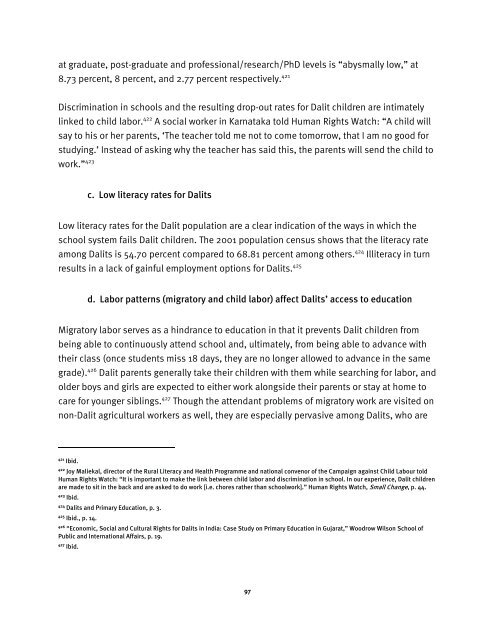Caste Discrimination against India's âUntouchablesâ - Human Rights ...
Caste Discrimination against India's âUntouchablesâ - Human Rights ...
Caste Discrimination against India's âUntouchablesâ - Human Rights ...
Create successful ePaper yourself
Turn your PDF publications into a flip-book with our unique Google optimized e-Paper software.
at graduate, post-graduate and professional/research/PhD levels is “abysmally low,” at<br />
8.73 percent, 8 percent, and 2.77 percent respectively. 421<br />
<strong>Discrimination</strong> in schools and the resulting drop-out rates for Dalit children are intimately<br />
linked to child labor. 422 A social worker in Karnataka told <strong>Human</strong> <strong>Rights</strong> Watch: “A child will<br />
say to his or her parents, ‘The teacher told me not to come tomorrow, that I am no good for<br />
studying.’ Instead of asking why the teacher has said this, the parents will send the child to<br />
work.” 423<br />
c. Low literacy rates for Dalits<br />
Low literacy rates for the Dalit population are a clear indication of the ways in which the<br />
school system fails Dalit children. The 2001 population census shows that the literacy rate<br />
among Dalits is 54.70 percent compared to 68.81 percent among others. 424 Illiteracy in turn<br />
results in a lack of gainful employment options for Dalits. 425<br />
d. Labor patterns (migratory and child labor) affect Dalits’ access to education<br />
Migratory labor serves as a hindrance to education in that it prevents Dalit children from<br />
being able to continuously attend school and, ultimately, from being able to advance with<br />
their class (once students miss 18 days, they are no longer allowed to advance in the same<br />
grade). 426 Dalit parents generally take their children with them while searching for labor, and<br />
older boys and girls are expected to either work alongside their parents or stay at home to<br />
care for younger siblings. 427 Though the attendant problems of migratory work are visited on<br />
non-Dalit agricultural workers as well, they are especially pervasive among Dalits, who are<br />
421<br />
Ibid.<br />
422<br />
Joy Maliekal, director of the Rural Literacy and Health Programme and national convenor of the Campaign <strong>against</strong> Child Labour told<br />
<strong>Human</strong> <strong>Rights</strong> Watch: “It is important to make the link between child labor and discrimination in school. In our experience, Dalit children<br />
are made to sit in the back and are asked to do work [i.e. chores rather than schoolwork].” <strong>Human</strong> <strong>Rights</strong> Watch, Small Change, p. 44.<br />
423<br />
Ibid.<br />
424<br />
Dalits and Primary Education, p. 3.<br />
425<br />
Ibid., p. 14.<br />
426<br />
“Economic, Social and Cultural <strong>Rights</strong> for Dalits in India: Case Study on Primary Education in Gujarat,” Woodrow Wilson School of<br />
Public and International Affairs, p. 19.<br />
427<br />
Ibid.<br />
97

















